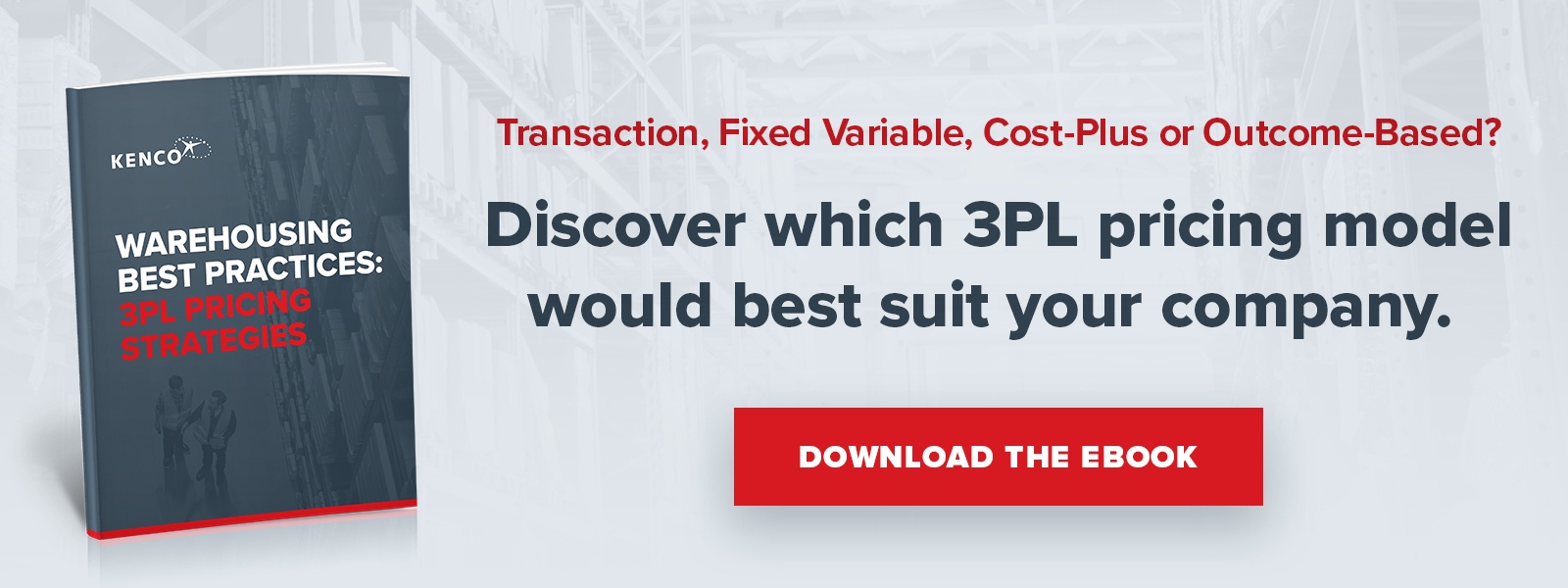
There is no such thing as a one-size-fits-all solution for business. Regardless of industry, audience, location, or product, any company deserves a customized contract and personal relationship with their third-party logistics company.
So when you ask, “What’s the best 3PL pricing model?” we’ll give you the dreaded answer of “It depends.”
The best pricing structure for your logistics solution will depend on a number of factors, including your goals, motivations, and even company culture. Keep in mind, the best fit for you now may not be the best fit for you in the future. It’s important to do regular audits to make sure you’re operating most efficiently.
There are four main pricing models to choose from, each of them being customizable. To help you choose the best pricing model for your warehouse, we have detailed some pros and cons of each model below.
Transaction / Unit Rates
Shipper:
Pro: Predictable financial planning with accurate forecasting, ease of billing review, lower financial risk, and the shipper can give very detailed instructions on what processes are to be included in each unit rate. The transactional/unit rate model can be easily utilized in shared facilities or for other processes like co-packing or kitting when using one of the other pricing models below for core services.
Con: Typically, the shipper pays higher margins. There is also less flexibility for out-of-scope projects; as negotiations and shipper approvals for the project are typically required. With this model, it is less likely to have continuous improvements flow continuously to the bottom line throughout the contract. For transactional/unit rate to be a successful model, SOPs need to be strictly followed. Finally, forecasting errors may result in missed service levels without penalty and can sometimes create a “nickel and dime” relationship.
3PL:
Pro: The transactional/unit rate model has the highest margin for the 3PL; with constant business profile/scope creep analysis there is the ability to charge hourly rates for out-of-scope projects. The 3PL will benefit from all continuous improvements and cost savings until the next contractual negotiation. Additionally, volume brackets protect margins and forecasting errors by the customer can result in service level forgiveness.
Con: With transactional/unit rate pricing models, the profitability risk is high as well as needing strict management of SOPs and the contractual business profile. If the shipper’s forecast requires rapid labor and equipment onboarding availability in a tight market, could be difficult. Also, the shipper, in the bidding process may tend to isolate one transaction rate and if that one rate is out of line with other competitors instead of looking at all unit rates combined for a total annual spend.
Fixed Variable
Shipper:
Pro: The fixed variable model allows collaboration on what is to be included and excluded as a fixed and variable expense; typically resulting in lower margins for 3PL than transactional/unit rates. The continuous improvements on variable expenses will fall to the shipper. The fixed variable model offers more collaboration in forecasting and financial visibility, and still has a level of predictability which provides improved flexibility in the partnership.
Con: Any improvement in the fixed operational costs flow directly to the 3PL’s bottom line. There is a little more risk in the financial area compared to unit rates, as well as the management of all true expenses is vailed.
3PL:
Pro: This model offers good margins with less risk, unlike transactional/unit rates; it helps to hold profitability and fixed expenses in low volume periods. It also can set thresholds of direct and indirect labor FTE’s with sustained volume increases, ease of billing, and offers improved collaboration with the shipper.
Con: The management of the business profile may require additional labor with the fixed variable model. The SOPs and the contractual agreement requires strict adherence to maintain profitability and avoid scope creep. Also, maintaining service levels may be difficult without good forecasting from the shipper, so contractual negotiations are needed around variable volumes and associated guardrails
Open Book / Cost Plus
Shipper

Pro: Typically, lowest margin percentage charged by 3PL. Cost plus offers full visibility of all expenses and helps to identify areas for improvement. The ability to recognize the financial effect of continuous improvements is immediate. Also, it offers more flexibility for the 3PL to react quickly to requests and market conditions, rapid expansion, and with better service level adherence. All 3PL expenses and costs are exposed and up for discussion.
Con: May think open book means “open checkbook”; With the cost plus model supply chain decisions and agility may mean more expenses under certain market conditions, like labor pressures. Typically, cost plus demands tighter controls, more time for invoice review, and line by line comparisons from month to month. This may incentivize the 3PL not to reduce expenses as margin dollars will erode.
3PL:
Pro: Cost plus gives the 3PL the lowest financial risk; as well, help to create a collaborative relationship with a shipper. A more collaborative partnership increases opportunities to have open expense discussions giving the 3PL and shipper the ability to impact cost reductions. All expenses are “open book” which all tends to make the budget process simpler.
Con: As total revenues reduce largely from making improvements are made, margin dollars are reduced; narrow margins require strict budget controls; contractual changes in items like payment terms and payment cycle have impacts and require new negotiations; some shippers will not participate in this model.
Outcome-Based Models
Pros: Outcome-based models like vested or gain share partnership models, reward both the shipper and the 3PL. Based upon performance and the level of sustained improvements complete over a certain threshold, the shipper and 3PL share in those savings. Together, the shipper and 3PL look for ways, either inside the four walls or outside the four walls of the distribution center on ways to improve costs of the overall supply chain. With performance comes shared reward in financial improvements and typically longer-term partnerships.
Cons: Designing an equitable vested or gain share partnership typically required establishing a baseline for the operations, which typically is one year or more. The “more” maybe because of acquisitions or market changes. It also requires both parties to focus on the overall improvements to the operation.
To Sum It Up
The right 3PL pricing strategy depends largely on your business principles and direction your company wants to take with its partners: not simply what you sell, but your culture and philosophy. If you want to know more about choosing the right pricing structure for your business while working with a 3PL partner for your logistics needs, you'll need some expert advice. Read our In-Depth Guide to 3PL Pricing for the additional insights.



